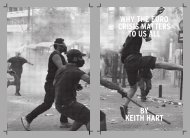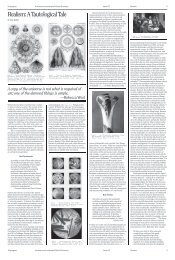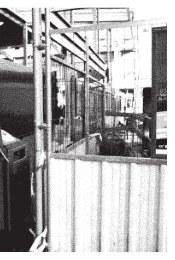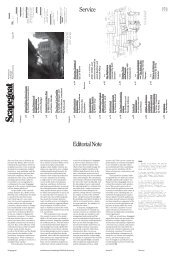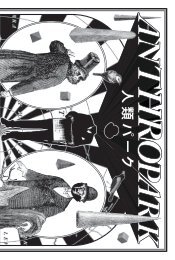Pier Vittorio AURELI, Manet - Scapegoat
Pier Vittorio AURELI, Manet - Scapegoat
Pier Vittorio AURELI, Manet - Scapegoat
Create successful ePaper yourself
Turn your PDF publications into a flip-book with our unique Google optimized e-Paper software.
<strong>Scapegoat</strong> Architecture/Landscape/Political Economy<br />
Issue 03 Realism<br />
11<br />
3 4<br />
fully aware of the problematics of looking at a picture. 8<br />
As is well known, the relationship between the artwork and its<br />
beholder has been the central focus of Fried’s criticism. For him,<br />
a work of art must be finite in itself and not dependant on the<br />
viewer’s subjective response. The moment art depends on subjective<br />
response it becomes “theatre,” loses its integrity, and interferes<br />
with the everyday experience of the beholder. As is also well<br />
known, Fried developed a critique of theatricality in his canonical<br />
essay “Art and Objecthood,” in which he attacked minimal art. 9 In<br />
this essay, he argued that the literalness of work by artists such as<br />
Donald Judd and Robert Morris implied that a work of art is always<br />
incomplete and requires the direct engagement of the viewer—and<br />
her capacity to move around the artwork—to be fully realized. In<br />
this way the boundary between art and what is not necessarily art<br />
is blurred in a situation that resembles our normal everyday condition.<br />
As Fried argues, “we are all literalists most of our lives.” 10 For<br />
this reason, Fried called for an art that was radically complete without<br />
the need to engage the active participation of the viewer. For<br />
Fried such art included, for example, the paintings by Morris Louis<br />
and Kenneth Noland, or the sculptures by Anthony Caro, in which<br />
what was expressed were the relationships within the work itself.<br />
For example, in paintings by Louis, the relationship between the<br />
rivulets or strips of colour and the rectangular blank canvas is so<br />
strong and complete that it presupposes an arrested, “transfixed”<br />
beholder in front of them. On the contrary, minimalist artworks<br />
are experienced through a situation of radical indeterminacy with<br />
respect to subjective response. This means that the intentions of<br />
the artists are no longer recognizable since they become confused<br />
with the subject’s experience of the artwork itself. It was within this<br />
preoccupation that Fried rediscovered Denis Diderot’s critique of<br />
theatricality in painting. 11 For Diderot, paintings were produced in<br />
order to be seen and this condition resulted in the excessive rhetorical<br />
play of the figures and scenes depicted. Diderot called for<br />
a painting style liberated from this primordial convention, as what<br />
was depicted would exist without a beholder in front of it. Fried<br />
recognized a Diderotian approach in the paintings of Chardin, such<br />
as Young Student Drawing, in which the French painter portrays<br />
a man seen from the back completely absorbed in the activity of<br />
drawing. Fried defined this condition of the subject as “absorption,”<br />
as opposed to the theatricality of more traditional painting in which<br />
everything is active in order to entertain the beholder. However,<br />
this interpretation of an anti-theatrical art came to a crisis when<br />
Fried was confronted with the work of <strong>Manet</strong>. Unlike the absorbed<br />
figures of Chardin’s pictures, in <strong>Manet</strong>’s paintings, the figures often<br />
address the beholder in an almost aggressive way. This is evident<br />
in famous pictures such as Le déjeuner sur l’herbe and Olympia.<br />
According to Fried, in these paintings the condition of beholding<br />
a picture is directly registered into the painting itself and thus<br />
the actual beholder is placed in an unprecedented position. Even<br />
though <strong>Manet</strong> is a theatrical painter in the Diderotian sense of the<br />
term, the radical frontal approach of his compositions—what Fried<br />
called the condition of “facingness”—makes evident the primordial<br />
convention that a picture must be beheld with a new force and<br />
explicitness. For Fried, such ostensible theatricality becomes a<br />
profound critique of theatricality, because by making it so explicitly<br />
evident, the painter reinforces the distance and thus the confrontation<br />
between the image and the beholder, who is then made aware<br />
of the constructedness of the picture itself.<br />
Recently, Fried has rediscovered such an approach in contemporary<br />
photography, especially the work of the photographers affiliated<br />
with the so-called Dusseldorf School, such as Andreas Gursky,<br />
Candida Höfer, and Thomas Struth. 12 In their work, the image is<br />
clearly constructed in order to be beheld. And yet it is precisely this<br />
factor that makes these photographs non-illusionistic depictions of<br />
reality. For example, as Fried has argued, Gursky’s images are spectacularly<br />
open to visual inspection because of their wealth of details,<br />
yet they rebut any possibility of representing a particular point<br />
of view that could be taken by someone in front of the photograph.<br />
For Fried, such a condition of radical facingness produces a “severing”<br />
effect between the photograph and the viewer. By reading<br />
the paintings of <strong>Manet</strong> and the work of these contemporary photographers,<br />
Fried seems to suggest the possibility that images can<br />
be radically themselves by emphazising their condition of being<br />
beheld. By making clear that the image is made in order to be seen,<br />
the producer of the image destroys the aura of the picture, which is<br />
its illusionistic status, its claim to offer a privileged “view” on reality.<br />
Above all, the severing of images from the viewer attacks one<br />
of the most crucial powers of images: inviting the viewer to interact<br />
with them by identifying her real experience of space with what is<br />
depicted in the image. Such interaction and identification between<br />
picture and viewer, subject, and object, is today a fundamental<br />
characteristic of the productive and re-productive apparatuses of<br />
the post-Fordist economy in which subjects are governed by making<br />
them active participants in the spectacular production of their<br />
own experience. The work of <strong>Manet</strong>, and the critical discourse that<br />
it originated, suggests a radical alternative to the contemporary<br />
regime of image production, as well as the production of architecture.<br />
This radical alternative consists in assuming that images are<br />
finite constructs, material objects with their own material properties.<br />
The radical lesson of <strong>Manet</strong>’s images is that they are not mere fragments<br />
of the world; rather, they are objects in themselves that not<br />
despite, but because they accept and even exalt their condition of<br />
being beheld, confront beholders as something separated, severed<br />
from them. ×<br />
Images Captions<br />
Diploma Projects,<br />
Architectural Association, London.<br />
Tutors: <strong>Pier</strong> <strong>Vittorio</strong> Aureli,<br />
Barbara Campbell -Lange, Fenella Collingridge.<br />
left to right:<br />
1. Jorgen Tandberg, Immeuble Cité in Antwerpen:<br />
A house for 1600 inhabitants, perspective,<br />
2010.<br />
2. Jorgen Tandberg, Immeuble Cité in Antwerpen:<br />
A house for 1600 inhabitants, perspective,<br />
2010.<br />
3. Tijn van de Wijdeven, We Need Stuff:<br />
Emptiness as a strategy, interior, 2011.<br />
4. Tijn van de Wijdeven, We Need Stuff:<br />
Emptiness as a strategy, promenade, 2011.<br />
Notes<br />
1. Nicholas Bourriaud, Relational Aesthetics<br />
(Paris: Le Press du Réel, 1998).<br />
2. See especially Christian Marazzi, Capital<br />
and Affects (Los Angeles: Semiotext(e),<br />
2010).<br />
3. Michael Fried, <strong>Manet</strong>’s Modernism, or, The<br />
Face of Painting in the 1860s (Chicago:<br />
University of Chicago Press, 1998), 25.<br />
4. Georges Bataille, <strong>Manet</strong> (Geneva: Skira,<br />
1955).<br />
5. Carole Talon-Hugon, “<strong>Manet</strong> o lo smarrimento<br />
dello spettatore”, in Michel Foucault, La<br />
pittura di <strong>Manet</strong>, ed. Maryvonne Saison,<br />
trans. Simona Paolini (Milan: Abscondita,<br />
2005), 75.<br />
6. Michel Foucault, <strong>Manet</strong> and the Object of<br />
Painting (London: Tate, 2011), 15.<br />
7. Ibid., 50.<br />
8. Fried, <strong>Manet</strong>’s Modernism, 18.<br />
9. Michael Fried, “Art and Objecthood,” in<br />
Artforum 5 (April 1967): 12-23. Reprinted in<br />
Michael Fried, Art and Objecthood (Chicago:<br />
The University of Chicago Press, 1998),<br />
148-172.<br />
10. Ibid., 168.<br />
11. Michael Fried, Absorption and Theatricality:<br />
Painting and Beholder in the Age of Diderot<br />
(Chicago: University of Chicago Press,<br />
1998).<br />
12. Michael Fried, Why Photography Matters As<br />
Art As Never Before (New Haven, London:<br />
Yale University Press, 2008).<br />
<strong>Pier</strong> <strong>Vittorio</strong> Aureli is an architect and<br />
educator. He is the co-founder of Dogma, and<br />
teaches at the Architectural Association in<br />
London. Aureli is the author of several books,<br />
including The Project of Autonomy: Politics<br />
and Architecture Within and Against Capitalism<br />
(2008), and The Possibility of an Absolute<br />
Architecture (2011).<br />
<strong>Scapegoat</strong> Architecture/Landscape/Political Economy<br />
Issue 03 Realism<br />
11



